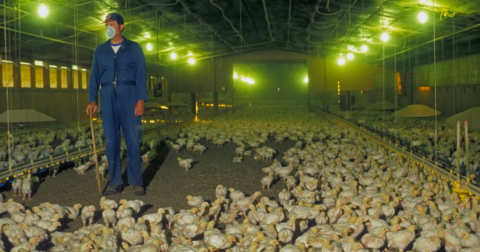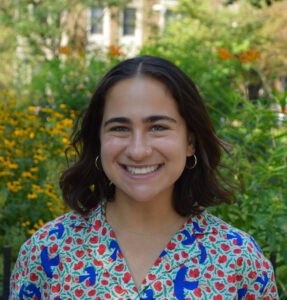Explainer
7 Tips for a More Sustainable Holiday Celebration
Climate•4 min read
Feature
At a township hearing, a developer revealed the 350,000 chickens would be kept mostly separate from the solar panels and probably “don’t go outside much.”


Words by Nina B. Elkadi
Jeff Hiserman loves Muncy Creek Township so much he wants to be “buried in the backyard” of his home. That is, unless, Sunny Side Up Farms LLC, a 350,000 head “cage-free, free-range” chicken farm and solar project, gets put in “200 yards” from his front door. The poultry project has been pitched as an integrated solar and chicken farm, a new land use practice known as agrivoltaics. But agrivoltaics projects typically envision animals grazing underneath solar panels — not hundreds of thousands of confined chickens packed into sheds.
Since April, Hiserman and his neighbors have been gathering at the truck bay of the Muncy Area Volunteer Fire Department, where the zoning board hearings are held, to question the joint venture between Bollinger Solar LLC and Ag Ventures LLC. In Muncy Creek Township, these hearings resemble court: Counsel is present, and witnesses are called to the stand. Over the course of multiple hearings, counsel for the zoning board has questioned representatives from the poultry and solar companies, drawing out details about the project’s animal welfare and environmental impacts. The testimony revealed the chickens may not ever see the light of day, and the actual integration between the solar panels and the chickens is minimal, if in existence at all.
When questioned on this, the solar project developer said that, to be honest, he was just “in the business of making money.”
Hiserman was sitting about 20 feet behind the developer when he said that. “I looked at my wife, and we both laughed out loud,” he says. “That was a pretty trying moment.”
Hiserman is a member of the Muncy Area Neighborhood Preservation Coalition, a group opposed to the project. A group of residents within the coalition have lawyered up, retaining attorney Zachary DuGan to represent them in their fight against the project. Hiserman himself cannot speak at the hearings because he is represented by counsel.
DuGan tells Sentient that at the crux of the case is the fact that this project, in its current proposed state, does not do enough to protect residents from the harmful effects of concentrated animal feeding operations, often called CAFOs or, colloquially, factory farms.
According to a recent EPA report, Pennsylvania has approximately 468 CAFOs, compared to approximately 4,000 in the leading state of Iowa. Most are clustered in Lancaster County, southeast of Muncy Creek Township, which is in Lycoming County, though the number has been increasing each year.
“The CAFO operation will negatively impact the health, safety, welfare of the surrounding residents,” DuGan says. Multiple residences are nearby, as is an elementary school and public water wells. His clients are worried about groundwater contamination, noise, dust, flies and “anything that would be common with the kind of CAFO use adjacent to residential homes.”
“I think they have stepped into what they thought was going to be a waltz, and we’ve put them now in the trenches,” Hiserman says. “You came to play? So did we.”
The climate pitch for agrivoltaics is that it optimizes land use. The National Renewable Energy Laboratory, a Department of Energy laboratory, describes agrivoltaics as: “creating energy and providing space for crops, grazing, and native habitats under and between panels.”
Under the Biden Administration, credits for solar panels, especially those in rural areas, were booming: Grant recipients could receive up to $1 million for renewable energy projects, including agrivoltaics. Despite cuts to this funding by the Trump Administration, the developers have not backed down on the project proposal. In their conditional use application, the solar project developers characterized the chickens’ outdoor access as limited, writing that “poultry from the proposed CAFO may also be able to access certain areas beneath the panels as an agrivoltaic use, depending on the poultry integrator utilized at any given time.” The implication is that the chickens will be mostly confined and contained. As the developers write, “the Project is compatible with the nearby agricultural and residential uses.”
Certain egg integrators, like Cal-Maine, are known for their “cage-free” eggs. In industrialized agriculture operations, an integrator typically controls the entire process — in the case of eggs, they own the chickens, the feed and anything they produce, like the eggs. The land and the sheds serve as a site for the integrator. By pitching this as an agrivoltaic project then, the minds behind Sunny Side Up LLC might be hoping to attract integrators who pitch their eggs as “free-range” or “cage-free.”
On April 16, 2025, project manager Cody Snyder, of the CAFO part of the project, Ag Ventures, took to the stand in Muncy Creek Township. “This is a cage-free, free-range operation,” Snyder said at the hearing. The United States Department of Agriculture definition of “cage-free” does not require chickens to have access to the outdoors. Free-range chickens, on the other hand, must have access to the outdoors, which could mean a small plot of concrete outside of a facility, though it does not necessarily mean they actually go out. Large fans, which the developers noted they will have to dry the manure and keep the smell at bay, are often so strong they create “hurricane level” winds that deter chickens from leaving.
Under those federal rules, Sunny Side Up would likely meet the requirements to label the eggs “free-range” and “cage-free.” At a hearing, Snyder stated that each of the five barns on the property would house 70,000 chickens, and each barn would be 88 feet wide by 616 feet long.
Per chicken then, this would likely give each bird under 1 square foot of space, not including the space taken up by the egg conveyor belt and manure storage area inside. In the same testimony, Snyder told the room, “I’ll be honest with everyone here. The chickens don’t go outside much.”
“I think they’re just looking at the big dollar sign overall,” Hiserman says. “‘Let’s get 350,000 chickens. Let’s get 51,000 solar panels. Let’s make some bucks. We got 100 plus acres in the middle of nowhere in North Central Pennsylvania. Let’s do it.’ Well, it’s not so easy.”
The chickens at this egg-laying operation are projected to produce 10 million pounds of manure each year. That manure is typically stored and then applied to crop farms. Sometimes, as would be the case for the Sunny Side project, that involves having to transport the manure.
Snyder testified that the operation would have capacity to store manure for a year but would likely export it away from the facility twice a year. “There is not really any land to put the manure,” he said, referring to the lack of large crop farms in the nearby area, “so we would be exporting this chicken manure.” But Snyder expressed confidence at finding takers, adding, “like I said, it is not hard to get rid of.”
Manure storage from concentrated animal feeding operations is a contentious topic, whether exported or not. Just the storage itself creates risks, from manure leaching into groundwater to the fumes generated as it decomposes. Transport adds more risk on top of that.
In the case that chickens are allowed to range under the solar panels, there is currently no plan in place for their defecation outside. Even if just five percent of the flock is outside at any given time, that would be 17,500 chickens, producing approximately 500,000 pounds of manure per year.
“Any manure that occurs outside will be left where it lies,” engineer Jonathan Zartman said at a hearing on August 4.
Any dead chickens would be placed in the manure pits to decompose. Broken eggs, too, would be placed in the manure area.
Steven Barrows, a resident and doctor, raised concerns in his testimony on April 24 about the health risks for the community. “I’m duty-bound to protect my patients and all of those children,” Barrows said at the hearing, referring to the elementary school located near the proposed CAFO site.
Barrows tells Sentient that studies show children who attend school near CAFOs are more likely to display asthma symptoms. “I think that provides enough justification for outright denial of the project, let alone all the other concerns,” he says.
The proposed site is located a quarter of a mile from Ward L. Myers Elementary School, but the project designers insist that this operation will not be a hindrance to the local community.
There is another hearing scheduled for the industrial poultry part of the project on September 4 at 7 p.m. At this meeting, clients represented by DuGan will present their case to the township supervisors, calling witnesses with expertise related to the many impacts the project poses, including engineering, ecology and human health. DuGan tells Sentient he expects that presentation to take multiple meetings.
After the record is eventually closed for testimony and evidence, the town supervisors will decide if conditional use should be approved, conditionally approved, or denied.
“I’m channeling my anger in this direction, because that’s where it needs to be channeled,” Hiserman says. “Put the energy into how we are going to win this thing and win it convincingly, so that other people can use this technique and maybe we can keep this kind of atrocity from happening.”